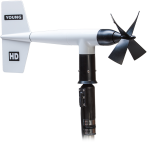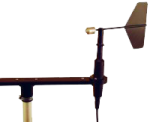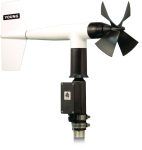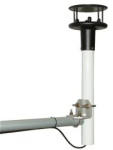
适用于Campbell Scientific大部分的数据采集器






概览
05305 风速风向传感器是一款重量轻,高效能测量风速和风向的传感器,专为空气质量领域设计。较其它传感器更为敏锐,制造商为R. M. Young,通过线缆与Campbell Scientific的数据采集器连接。
优势与特点
- Compatible with most Campbell Scientific data loggers
- Constructed with thermoplastic material that resists corrosion from sea-air environments and atmospheric pollutants
- Lower starting threshold, faster response, and higher accuracy than the other wind monitors
- Meets or exceeds requirements of the following regulatory agencies: U.S. Environmental Protection Agency, U.S. Nuclear Regulatory Agency, and American Nuclear Society
- Compatible with the LLAC4 4-channel Low-Level AC-Conversion Module, which increases the number of anemometers one data logger can measure
- Compatible with the CWS900-series interfaces, allowing it to be used in a wireless sensor network
图像

技术说明
05305-AQ 风速风向传感器 采用轻便,紫外线稳定的热塑塑料,不锈钢和阳极电镀铝材质。耐热塑料可抗击海洋空气环境的侵蚀,抵抗大气污染。精密级别的不锈钢滚珠轴承用于旋桨轴承和立式轴承。
专为海岸和海洋应用设计,经久耐用,05106采用防水的轴承润滑剂以及密封的高性能的尾线代替了标准接线盒。
05305 用四叶旋桨测量风速。旋桨转动产生与风速成正比的交流正弦波频率。传感器线圈中感应的交流信号由安装在传动轴六极磁铁生成。线圈固定在不能旋转的主安装组件的中部,省去了滑环和电刷。
连接在内部电位计上的机身状的传感器被用来感应风向。数据采集器将已知的精确的激发电压传向电位计元件。输出的模拟电压信号与方位角成正比。
05305-AQ 风速风向传感器专为测量空气质量设计,低启动阈值,响应迅速,高精确度。它符合或超过由以下监管机构公布的要求:
- 美国环保局环境监测预防指南--显着恶化(PSD)和现场气象仪器要求表征扩散点源
- 美国核监管机构NRC监管指南1.23--核电站气象程序
- 美国核学会核电站气象标准
产品规格
| Applications |
|
| Sensor | Helicoid-shaped, 4-blade propeller and fuselage-shaped sensor body |
| Measurement Description | Wind speed and direction |
| Operating Temperature Range | -50° to +50°C (assuming non-riming conditions) |
| Mounting Pipe Description |
|
| Housing Diameter | 5 cm (2.0 in.) |
| Height | 38 cm (15.0 in.) |
| Length | 65 cm (25.6 in.) |
| Propeller Diameter | 20 cm (7.9 in.) |
| Weight | 1.1 kg (2.5 lb) |
Wind Speed |
|
| Range | 0 to 50 m/s (0 to 112 mph) |
| Accuracy | ±0.2 m/s (±0.4 mph) or 1% of reading |
| Starting Threshold | 0.4 m/s (0.9 mph) |
| Distance Constant | 2.1 m (6.9 ft) 63% recovery |
| Output |
ac voltage (three pulses per revolution) 90 Hz (1800 rpm) = 9.2 m/s (20.6 mph) |
| Resolution | (0.1024 m s-1) / (scan rate in seconds) or (0.2290 mph) / (scan rate in seconds) |
Wind Direction |
|
| Mechanical Range | 0 to 360° |
| Electrical Range | 355° (5° open) |
| Accuracy | ±3° |
| Starting Threshold | 0.5 m/s (1.0 mph) at 10° displacement |
| Distance Constant | 1.2 m (3.9 ft) 50% recovery |
| Damping Ratio | 0.45 |
| Damped Natural Wavelength | 4.9 m (16.1 ft) |
| Undamped Natural Wavelength | 4.4 m (14.4 ft) |
| Output |
|
| Voltage | Power switched excitation voltage supplied by data logger |
兼容性
Mounting
The 05305 can be attached to a crossarm via a 17953 NU-RAIL fitting or CM220 Right Angle Mounting Bracket. Alternatively, it can be attached to the top of a CM106B or a stainless-steel tripod via the CM216 Sensor Mounting Kit.
Programming
The 05305's propeller is measured by the PulseCount Instruction in CRBasic and by Instruction 3 (Pulse Count) in Edlog. The wind vane is measured by the BrHalf Instruction in CRBasic and by Instruction 4 (Excite-Delay-SE) in Edlog. The measurements are typically processed for output with the Wind Vector instruction (not present in the CR500 or CR9000 but is present in the CR9000X).
视频与教程
常见问题解答
05305-L: 6
展开全部收起全部
-
This depends on what is broken. Typically, Campbell Scientific can repair the unit, and the user does not have to purchase a new one.
-
The short answer is less than 0.01 mA. The wind speed signal requires no power. The wind direction portion of the sensor only uses a maximum of 0.5 mA when excited with 5 Vdc, and then it is only on for 0.016 s for every measurement. When the wind direction is measured every second (typical), the average current drain is less than 0.01 mA.
-
Orientation of the wind monitor is done after the data logger has been programmed, and the location of True North has been determined. True North is usually found by reading a magnetic compass and applying the correction for magnetic declination, where magnetic declination is the number of degrees between True North and Magnetic North. Magnetic declination for a specific site can be obtained from a USFA map, local airport, or through a computer service.
-
The information included on a calibration sheet differs with each sensor. For some sensors, the sheet contains coefficients necessary to program a data logger. For other sensors, the calibration sheet is a pass/fail report.
-
- Using Short Cut, click the applicable wind direction sensor in the Selected Sensors list of the Outputs screen.
- The two output options enabled are Sample and WindVector. Select WindVector.
- The WindVector instruction has output options. Select an option with mean wind direction in it.










